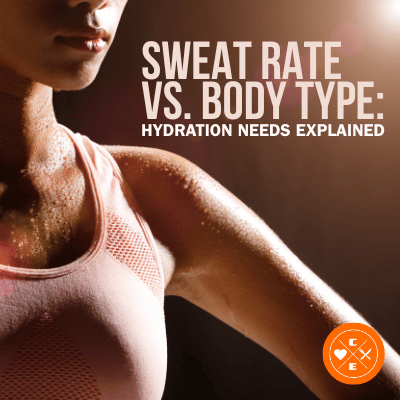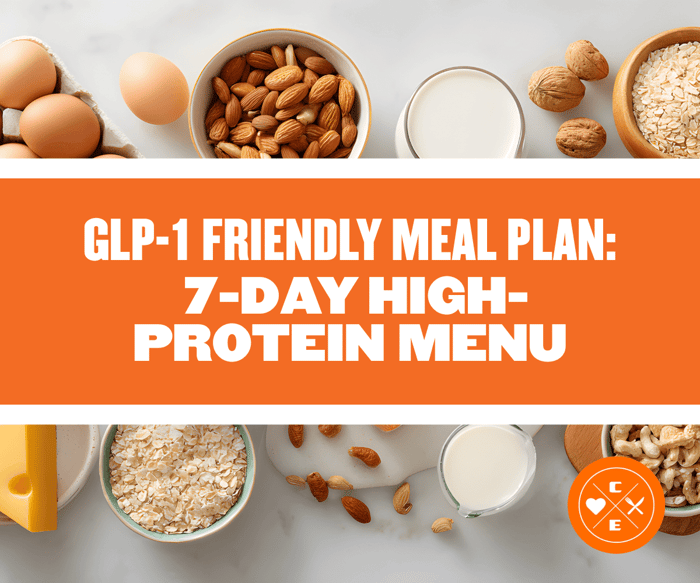Sweat Rate vs. Body Type: Hydration Needs Explained

Jason Nista
Nutrition
09/30/2025 9:36am
11 minute read
Your hydration needs depend on two main factors: how much you sweat and your body type. Sweat rate measures how much fluid you lose during exercise, which can vary based on activity, temperature, and fitness level. Body type, including muscle mass and fat percentage, affects how your body regulates heat and stores water. Together, these factors determine how you should replace fluids to avoid dehydration or overhydration.
Key Takeaways:
- Sweat Rate: Measure fluid loss by weighing yourself before and after exercise. For every pound lost, you lose about 16 oz of water.
- Body Type: Larger or more muscular individuals sweat more, while leaner or smaller bodies sweat less but still need electrolytes.
- Electrolytes: Sodium is the main mineral lost through sweat. "Salty sweaters" may need more sodium replacement.
- Hydration Tips:
- Drink 16-20 oz of water 2-3 hours before exercise.
- Replace 75-80% of fluids lost during activity.
- Rehydrate with 150% of lost fluids post-exercise.
By combining sweat rate and body type insights, you can fine-tune your hydration strategy for better recovery and performance.
Sweat Rate: The Key to Optimal Hydration for Performance
1. Sweat Rate
Sweat rate refers to the amount of fluid your body loses during exercise, measured in fluid ounces per hour. This number can vary widely depending on the person and the activity. For example, someone doing light exercise might lose only 12-16 fluid ounces per hour, while intense training could push that number to 64 fluid ounces or more.
Several factors play into your personal sweat rate. Fitness level is key - trained athletes tend to sweat more efficiently and in larger amounts compared to casual exercisers. Body size matters too; larger individuals typically sweat more because they have more sweat glands. Environmental conditions also make a huge difference. Exercising in 90°F with high humidity can triple your sweat loss compared to working out in a 70°F air-conditioned space.
Fluid Loss
Knowing how much fluid you lose during exercise is essential for creating a solid hydration plan. A simple way to estimate your sweat rate is by weighing yourself before and after a one-hour workout. Don’t forget to account for any fluids you drink during that time.
For every pound lost, you’ve shed about 16 fluid ounces of water. For example, if you lose 2 pounds and drink 20 fluid ounces during your workout, your total fluid loss is approximately 52 fluid ounces.
Climate plays a big role in these numbers. Hot, humid environments or deserts can push sweat rates over 80 fluid ounces per hour for some athletes. On the flip side, cool and dry conditions might keep your losses under 20 fluid ounces per hour for the same activity.
Electrolyte Loss
Sweat isn’t just water - it also carries away key minerals your body needs, known as electrolytes. Sodium is the primary electrolyte lost, with concentrations typically ranging from 200-1,000 milligrams per liter of sweat. Other minerals like potassium, magnesium, and chloride are also lost, though in smaller amounts.
The concentration of electrolytes in your sweat can vary. Well-trained athletes often lose less sodium because their bodies adapt to conserve these minerals, even though they may sweat more overall. On the other hand, newer exercisers or those not used to hot conditions tend to lose higher amounts of sodium and other electrolytes.
If you notice white stains on your workout clothes or taste salt when sweat drips into your mouth, you might be a "salty sweater." This means you’re losing a lot of sodium and need to pay extra attention to replacing those electrolytes.
Hydration Strategies
To stay ahead of dehydration, drink 16-20 fluid ounces of water 2-3 hours before your workout. Then, have another 8 fluid ounces about 15-20 minutes before starting. This helps ensure you’re well-hydrated before you begin.
During exercise, aim to replace about 75-80% of the fluids you lose. For example, if your sweat rate is 40 fluid ounces per hour, try to drink 30-32 fluid ounces per hour while you’re active. For workouts lasting longer than 60-90 minutes, include electrolytes by using sports drinks or tablets.
After exercise, your goal is to drink 150% of the fluids you lost over the next 4-6 hours. If you lost 2 pounds during your workout, you should aim to drink around 48 fluid ounces to fully rehydrate. Pair this with balanced meals containing natural electrolytes to speed up recovery - options like Clean Eatz Kitchen’s portion-controlled, nutrient-rich meals can help.
A quick way to check your hydration is by monitoring your urine color. Pale yellow means you’re well-hydrated, while dark yellow indicates you need more fluids. Keep in mind, though, that this method isn’t as reliable right after intense exercise since other factors can influence urine color.
Next, we’ll take a closer look at how your body type can further shape your hydration needs.
2. Body Type
Your body composition plays a key role in how much you sweat and how you should approach hydration. Factors like muscle mass, body fat, and metabolism all influence fluid loss, electrolyte balance, and hydration strategies.
Ectomorphs, who are naturally lean with fast metabolisms, generally sweat less. Mesomorphs, with their muscular builds, tend to sweat efficiently, while endomorphs, who carry more body fat, often sweat more due to increased heat retention. Let’s take a closer look at how these differences impact fluid loss and hydration needs.
Fluid Loss
Body size and composition directly affect how much fluid is lost during exercise. Larger individuals or those with more muscle mass naturally generate more heat, leading to higher sweat rates. On the other hand, higher body fat acts as insulation, causing the body to heat up faster and sweat more, which means hydration becomes a priority sooner and in greater amounts.
Electrolyte Loss
Electrolyte loss also varies based on body composition. For example, individuals with more muscle mass may require more potassium, as their muscles rely heavily on it for proper function. Those with larger body sizes or higher fat percentages typically lose more sodium because they sweat more. Interestingly, regular training can help the body conserve sodium over time, but these differences still call for hydration strategies tailored to your specific body type.
Hydration Strategies
To stay properly hydrated, it’s important to adjust your approach based on your body type. For larger individuals, drinking more fluids before exercise can be beneficial. Personalizing your hydration plan through sweat testing can also help fine-tune your needs.
During long workouts, hydration should be matched to your body’s requirements. If you have a muscular build, sports drinks with higher electrolyte concentrations might be a better choice. Meanwhile, leaner individuals may find that plain water suffices for shorter sessions, but they should still prioritize electrolyte replacement during longer or more intense activities.
After exercise, recovery hydration is equally important. The amount of fluid you need to replace depends on your total body water, which is influenced by your body composition. While a common guideline is to replenish a significant portion of the fluids lost during exercise, the timing and volume will vary for each person.
For recovery, high-protein meals - like those from Clean Eatz Kitchen - can support muscle repair and help with fluid retention. By understanding your body type and sweat rate, you can refine your hydration strategy to perform at your best.
sbb-itb-1989a25
Pros and Cons
When it comes to tailoring your hydration plan, both the sweat rate and body type approaches have their upsides and limitations. Let’s break them down.
The sweat rate method measures fluid loss by comparing your weight before and after exercise. It’s a quick and practical way to get a sense of how much fluid you’re losing. However, this method isn’t perfect - it can be influenced by factors like temperature, humidity, and other environmental conditions.
On the other hand, the body type approach provides a steady framework since your body composition doesn’t change drastically over time. For instance, individuals with more muscle mass might need higher electrolyte intake compared to those with a leaner build. But this method falls short in extreme or highly variable conditions, where more precision is needed.
The best results often come from combining these two strategies. Use your body type as a baseline for hydration, then fine-tune your plan by observing how your body reacts in different environments. For example, hydration needs tend to remain more stable indoors, while outdoor activities may require adjustments based on the weather.
To enhance recovery, pair your hydration efforts with balanced, protein-rich meals, like those from Clean Eatz Kitchen. This supports both fluid balance and muscle repair. By integrating body type insights with sweat rate data, you can create a more effective and personalized hydration strategy that works in harmony with your recovery routine.
Conclusion
Getting hydration right means aligning your fluid intake with your body's sweat rate and unique composition. Neither factor alone can give you the full picture, but together, they create a solid strategy for staying properly hydrated.
Start by figuring out your baseline hydration needs based on your body type. If you have more muscle mass, you'll likely need more electrolytes. On the other hand, if you're leaner, focus on consistent fluid intake without overloading on sodium. From there, track your sweat rate across different activities and weather conditions to refine your plan. Combining these insights will help you create a hydration approach that works for your body.
Simple steps you can try today include paying attention to how heat and humidity impact your sweat rate. For indoor workouts, you might not need major adjustments, but outdoor sessions in the sun or high humidity will call for more fluids to keep up with your body's needs.
Nutrition plays a big role too. Pairing your hydration strategy with balanced, nutrient-rich meals can boost both recovery and performance. For example, weight loss meal plans start at $49.99, while high-protein options are available for $59.95, offering tailored solutions to support your goals.
The secret to success lies in consistency and flexibility. Monitor what works best for you, make tweaks when necessary, and adjust as your fitness level, environment, or objectives evolve. By giving your hydration the attention it deserves, you’ll set yourself up for better performance and well-being. Your body will thank you.
FAQs
How can I figure out my sweat rate to plan my hydration better?
To figure out your sweat rate, start by weighing yourself without clothes both before and after exercising. Keep track of how much fluid you drink during the workout, and if possible, note any urine output. Then, use this formula: sweat rate = (pre-exercise weight - post-exercise weight) + fluid intake - urine volume, divided by the duration of your exercise in hours. This calculation gives you a personalized estimate of how much fluid your body loses, making it easier to stay properly hydrated. Be sure to adjust for factors like exercise intensity, weather conditions, and your unique body type.
How should I adjust my hydration if I have more muscle mass than others?
If you have more muscle mass, your body tends to lose more water through sweat, particularly during intense activities where fluid loss can go beyond 2 liters per hour. A simple way to monitor your hydration needs is to weigh yourself before and after exercise. This helps you estimate how much fluid you've lost and how much you need to replace.
But hydration isn't just about water. Sweating also drains electrolytes like sodium and potassium, which are crucial for hydration and keeping your muscles working properly. Make sure to replenish these minerals, especially if you're sweating heavily. Tailoring your water and electrolyte intake to match your activity level and the environment can help you perform at your best and feel your best.
Why should I adjust my hydration based on the weather, and how can I do it effectively?
Adjusting your water intake to suit the weather is crucial because heat and humidity can significantly affect how much fluid your body loses through sweat. When it's hot or humid, your body has to work overtime to stay cool, which means you sweat more and are at a greater risk of dehydration.
To keep your hydration on point, drink more water during warm or humid days, especially if you're spending time outdoors or being active. Pay attention to what your body is telling you - feeling thirsty, having a dry mouth, or experiencing fatigue are common signs that you need to drink more. Keep a water bottle handy and sip regularly throughout the day to stay ahead of your body's hydration needs.
Related Articles
GLP-1 Friendly Meal Plan (2025): 7-Day High-Protein Menu
13 minute read
We Were on QVC! Meet Our 11g-Protein PB&J!
2 minute read


